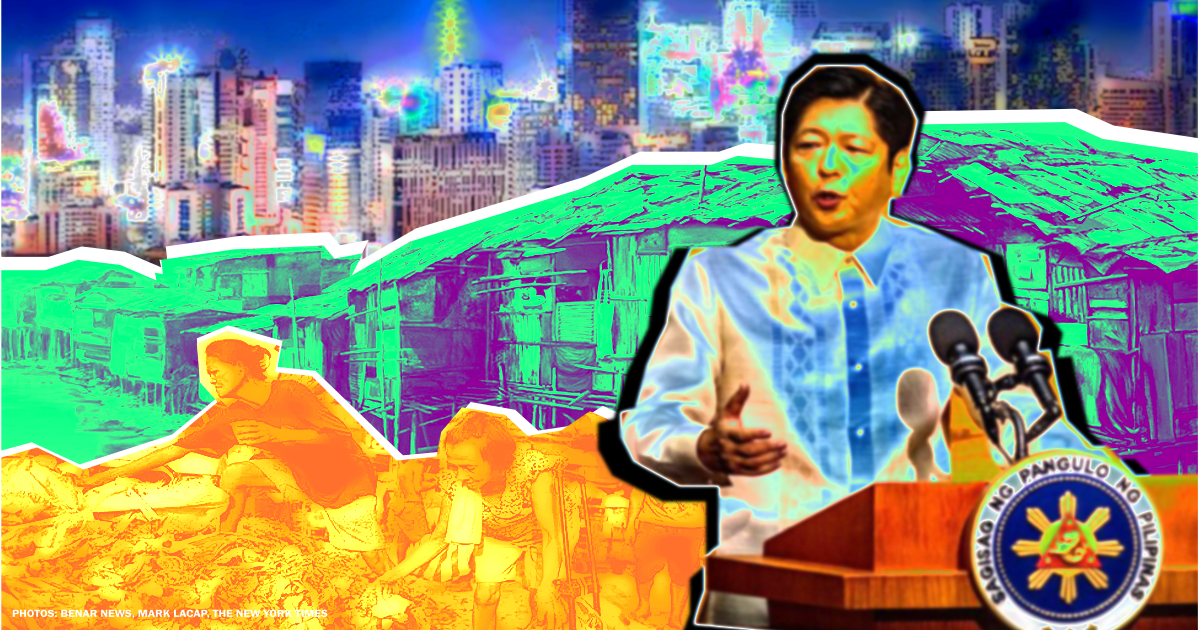There is so much cynicism about the country’s politicians that not too many probably ever expect the annual state of the nation address (SONA) performance to be forthright and objective. Every SONA speech aims to enhance the stature of the sitting president even if it means exaggerating achievements and efforts.
Pres. Ferdinand “Bongbong” Marcos Jr has already had two chances to break the self-serving SONA mold, but didn’t. This is even more unlikely in his upcoming third SONA. The administration is ratcheting up its “Bagong Pilipinas” branding campaign, the Marcos-Romualdez dynasty has unsheathed its swords against the upstart Duterte clan for the looming battle in 2025 and war in 2028, and the general public is economically distressed and restless.
These aren’t conditions for the third Marcos Jr SONA, a major propaganda event for the government, to be burdened with the truth. On the contrary, some bold distortions about the economy and the situation of the people can be expected. Five immediately come to mind.
(1) GDP growth delusion
Pres. Marcos Jr will hype the country’s economic growth as among the fastest in the region, to give the impression of good economic performance. The Philippines’ 5.5% gross domestic product (GDP) growth in 2023 was the fastest in Southeast Asia, and the 5.7% in the first quarter of 2024 was the second-fastest after Brunei’s 6.8% clip.
In 2025, the Asian Development Bank (ADB) and ASEAN+3 Macroeconomic Research Office (AMRO) project the Philippines as the second-fastest growing economy in Southeast Asia after Vietnam, while the International Monetary Fund (IMF) sees the country as the second-fastest growing in Asia.
Unfortunately, GDP growth’s stature as a measure of economic progress is undeserved and most Filipinos haven’t become better off because of this growth. The regional comparatives are endorphin-inducing as if development is a race. Yet it should be conspicuous that poverty and hunger are increasing despite glowing growth figures.
The number of self-rated poor families has soared by 3.4 million since the start of the Marcos Jr administration, from 12.6 million (49% of families) in June 2022 to 16 million (58%) in June 2024, according to the Social Weather Stations (SWS). The government might observe the same trend if it was monitoring poverty more frequently than every two years.
Still, there’s enough basis to estimate that there are some 19 million poor and vulnerable Filipino families. SWS estimates that seven-out-of-10 (70%) Filipino families rate themselves as poor or borderline as of June 2024. This is corroborated by the Bangko Sentral ng Pilipinas’ (BSP) survey finding that seven-out-of-10 (69%) Filipino households don’t have any savings.
Beyond crude GDP growth figures, the Philippines actually fares poorly compared to its neighbors. The Philippines has the second or third worst poverty incidence after Myanmar and Lao PDR. This is according to the latest poverty headcount figures at national poverty lines compiled by the World Bank in their World Development Indicators database and Poverty and Inequality Platform (PIP).
The bottom line? The simplicity of GDP and growth is what makes them poor measures of economic performance, especially in a country like the Philippines where the gains from growth are chronically cornered by a few at the expense of the many.
(2) Employment paradox
Pres. Marcos Jr will hype supposedly better labor market figures, to give the impression that people’s livelihoods are getting better. When the latest May 2024 labor force survey figures came out the administration claimed “positive momentum.” It hailed the unemployment rate dropping to 4.1%, the underemployment rate to 9.9%, and the “significant increase in high-quality jobs.” Hundreds of thousands of jobs were added since last year.
But if there are more jobs and unemployment is falling, why are there also more poor and a higher poverty incidence? The dirty little secret is that jobs are really of lower and lower quality and being reported as “employed” means less and less in terms of livelihoods. Also, official unemployment figures are understated because millions of discouraged jobless Filipinos have stopped being counted as unemployed.
Looking at the full-year labor figures takes away the seasonality in monthly reported results. In 2023, 48.2 million Filipinos were counted as employed and 2.2 million as unemployed. These are misleading. For a start, reported “employed” includes 3.9 million unpaid family workers who shouldn’t really be counted as remunerated work.
The overall problem though is that 32.1 million or some three-fourths (74%) of “employment” is overwhelmingly in poorly-paid no-or-zero-benefit irregular informal work, by IBON’s initial estimates using the latest available data. This includes 13.1 million self-employed (27%), 5.1 million in own family farms or businesses (11%), 2.1 million in private households (4.3%) and perhaps 15.1 million in wage and salary work in informal establishments (31%).
Which is not to say that the around 8.4 million wage workers in formal private establishments have it much better. As it is, the average real value of regional minimum wages nationwide is 26% smaller today than it was 35 years ago in 1989 when regionalization of wage-setting started. The balance of 4.4 million salaried workers is in the public sector which is no less notorious for low pay and contractualization.
IBON further estimates some 1.9 million discouraged but still jobless Filipinos that should be counted as among the unemployed, which bring total unemployment to four million – or even to 7.9 million including unpaid family workers. In short, seemingly positive labor force figures should be taken with a grain of salt especially when supposed labor market gains are accompanied by growing poverty.
(3) Inflation conundrum
Pres. Marcos Jr will hype measures to supposedly address inflation, to give the impression that the government has successfully controlled prices and brought the cost of living down. The administration has already patted itself on the back for “the persistent implementation of whole-of-government interventions to ensure that the purchasing power of every Filipino is protected.”
The public is clearly unconvinced though with 72% of Filipinos still feeling it is urgent for the government to address the rising prices of basic commodities, according to Pulse Asia. This figure closely corresponds to the seven-out-of-10 families that are apparently poor, vulnerable and without savings.
Inflation rose from 6.1% in June 2022 to a peak of 8.7% in January 2023. This moderated to an average of 6% for the whole of 2023 and 3.5% so far in the first five months of 2024. Yet although at a slower pace, prices are still generally rising with some acceleration from 2.8% in January 2024 to 3.9% in May 2024.
The aversion of the public to the continued price increases is understandable especially in the context of worsening disguised joblessness and informality that altogether just make basic goods and services even more unaffordable.
This is made worse by the infamous Php20 per kilo rice promise which was always just a cynical attention-getting populist gimmick by Pres. Marcos Jr. No country in the region has rice priced so low and it is fiscally and economically impossible for the Marcos Jr government to achieve. At current rice prices and levels of consumption, an outright price subsidy to sell rice at Php20/kilo would cost some Php400 billion annually. Supply-side interventions on the other hand would take years to take effect, and aiming for the target Php20 price would even have to be weighed first versus other uses of government resources.
In any case, benchmarking against other countries, the Philippines doesn’t seem to be doing too well and has the fourth highest inflation in the region after Myanmar, Lao and Vietnam.
Pres. Marcos took the helm of the agriculture department with the claim that he could jump-start the sector’s progress. But while the agriculture budget did jump from Php150 billion in 2022 to Php186 billion in 2023 and Php235 billion in 2024, agricultural, forestry and fishing growth averaged just 1% since the administration took office. This is slower than the 1.2% under the previous government and not even half the historical 2.3% average since 2001. Measured as output per employed in the sector, agricultural productivity in 2023 was even 15% lower than its peak in 2019. These raise questions about where the budget increases might have really gone if not to improving farm production.
(4) Ayuda tokenism
Pres. Marcos Jr will hype social assistance programs, to give the impression that the government is doing all it can to help economically distressed poor Filipinos. The administration bumped up its ayuda budget from around Php278 billion in 2023 to some Php356 billion in 2024 – mainly in programs of the social welfare, labor and health departments. This is aside from the Php467 million for the agriculture department’s Kadiwa program.
Figures in the billions may seem large in themselves and are certainly played up as substantial by the administration. However, they are relatively small compared to the magnitude of the problem at hand of some 19 million families with around 78 million Filipinos who should be considered poor and economically vulnerable.
The biggest ayuda program is the Pantawid Pamilyang Pilipino Program (4Ps) with around 4.5 million beneficiary families, the Assistance for Individual-In-Crisis Situation (AICS) has some 1.5 million beneficiaries so far, and the food stamps program will benefit at most 300,000 beneficiaries this year. The TUPAD emergency employment program’s budget may be stretched to reach some 3-4 million individuals if the payout made to them is minimal, and likewise with the Ayuda sa Kapos and Kita Program (AKAP).
The short-term band-aid assistance to families struggling with high prices and low incomes is unambiguously helpful even if still small. However, the abuse of these programs for self-serving political purposes is also glaring and it’s almost like politicians want to keep Filipinos poor and pliant with patronage.
(5) Infrastructure illusions
Pres. Marcos Jr will hype the government’s Build, Better, More infrastructure program, to give the impression of the country upgrading and the economy improving. The Php1.5 trillion public infrastructure budget is a considerable fund for building projects that are tangible and visible to the public and giving a feeling of economic progress.
The feeling is highly subjective. Public infrastructure spending has grown substantially. It almost quintupled from Php286 billion in 2013 to Php1.3 trillion 2023, and more than doubled from 2.4% of GDP to 5.3% over that period.
Infrastructure is often portrayed as pivotal to development. Yet it is conspicuous that this period still saw manufacturing fall as a share of GDP from 19.2% to 18% (the smallest in 75 years) and agriculture from 12.4% to 8.6% (the smallest in the country’s history) – indicating that while infrastructure has its benefits, agricultural and industrial development demands a much greater range of interventions that are absent.
It apparently does not deliver even on the narrow metric of growth. GDP grew at an annual average of 6.7% in the period 2013-2017 – peaking at 7.1% in 2016 – when there was less infrastructure spending. But then annual GDP growth started slowing in 2017 (6.9%), 2018 (6.3%) and 2019 (6.1%) even as infrastructure spending grew; after the pandemic lockdown and rebound in 2020-2022, the economy returned to its pre-pandemic trend of slowing growth in 2023 (5.5%).
Context matters
The president’s third SONA will try hard to portray a nation undergoing transformation in line with the administration’s “Bagong Pilipinas” branding. The SONA will try to convince with hyperbole, misdirection and misleading use of economic statistics. The context of the many extravagant claims that will be made matters though.
The facts will show that the unrepentantly unreformed elite-biased economic policies of the administration are causing the economy to slide backward on the things that matter the most – the agricultural and industrial foundations of the national economy and, most importantly, the people’s welfare.



